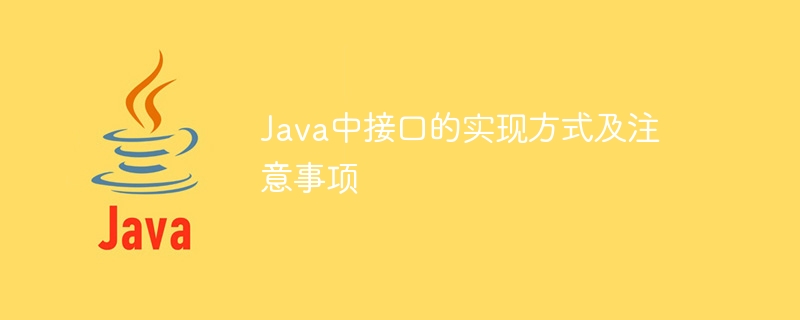Home >Java >javaTutorial >Methods and precautions for implementing Java interfaces
Methods and precautions for implementing Java interfaces
- PHPzOriginal
- 2024-01-03 15:59:48845browse

Implementation methods and precautions for interfaces in Java
Overview:
In Java, an interface is a convention that defines the signature of a set of methods , but there is no specific implementation. Through interfaces, decoupling between classes can be achieved and a writing specification is provided to facilitate multiple classes to implement the same behavior. This article will introduce the implementation of interfaces in Java and provide detailed code examples.
How to implement the interface:
Interfaces in Java can be implemented in two ways, namely, class implementation interface and anonymous class implementation interface.
- Class implementation interface:
Class implementation interface is the most common interface implementation method. To implement an interface, use the keyword "implements" followed by the class name followed by the interface name. After a class implements an interface, it must implement all methods declared in the interface.
// 定义一个接口
public interface Animal {
void eat();
void sleep();
}
// 实现接口的类
public class Cat implements Animal {
@Override
public void eat() {
System.out.println("猫吃鱼");
}
@Override
public void sleep() {
System.out.println("猫睡觉");
}
}
// 测试类
public class Main {
public static void main(String[] args) {
Cat cat = new Cat();
cat.eat();
cat.sleep();
}
}- Anonymous class implementation interface:
Implementing the interface through an anonymous class can omit the step of creating a new class, and is often used when only one-time interface instances are implemented. The format of the anonymous class implementing the interface is as follows:
接口名 对象名 = new 接口名() {
// 接口方法的具体实现
};// 定义一个接口
public interface Animal {
void eat();
void sleep();
}
// 测试类
public class Main {
public static void main(String[] args) {
// 匿名类实现接口
Animal cat = new Animal(){
@Override
public void eat() {
System.out.println("猫吃鱼");
}
@Override
public void sleep() {
System.out.println("猫睡觉");
}
};
cat.eat();
cat.sleep();
}
}Note:
- The class that implements the interface must implement all methods in the interface, otherwise it will cause a compilation error.
- Methods in the interface are public and abstract by default. Therefore, when implementing the interface, the method must have public permissions and cannot contain a method body.
- A class can implement multiple interfaces by separating the interface names with commas.
- Interfaces can inherit other interfaces by using the keyword "extends".
- The instantiation of the interface must be done through an implementation class or an anonymous class.
Summary:
Interface in Java is an important design pattern, which provides a specification for multiple classes to implement the same behavior. This article introduces the implementation of interfaces in Java, including class implementation interfaces and anonymous class implementation interfaces, and provides detailed code examples. At the same time, the interface precautions are also explained in detail. In actual development, rational use of interfaces can improve code reusability and maintainability, making the program more flexible and scalable.
The above is the detailed content of Methods and precautions for implementing Java interfaces. For more information, please follow other related articles on the PHP Chinese website!
Related articles
See more- C# development considerations: multi-threaded programming and concurrency control
- Vue Development Notes: Avoid Common Memory Usage and Performance Issues
- C# Development Notes: Safe Programming vs. Defensive Programming
- C# Development Notes: Security Vulnerabilities and Risk Management
- Vue Development Notes: Avoid Common Mistakes and Pitfalls

